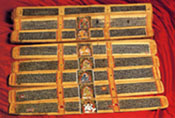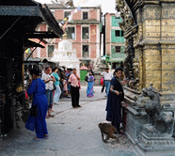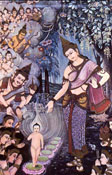 For
more than a generation, scholars and teachers relied primarily on sources
from the Buddhist canon and commentaries. Consequently, the study and
teaching of Buddhism focused on the philosophical and religious doctrines
preserved and transmitted among monastic and intellectual communities.
Within the past two decades, primary source materials from anthropological
fieldwork have extended scholars' working definitions of Buddhism to include
the rituals and practices observed within both monastic and lay communities.
This change in emphasis and new body of information
For
more than a generation, scholars and teachers relied primarily on sources
from the Buddhist canon and commentaries. Consequently, the study and
teaching of Buddhism focused on the philosophical and religious doctrines
preserved and transmitted among monastic and intellectual communities.
Within the past two decades, primary source materials from anthropological
fieldwork have extended scholars' working definitions of Buddhism to include
the rituals and practices observed within both monastic and lay communities.
This change in emphasis and new body of information  has
significantly widened and deepened our cultural understanding of Buddhism
from a set of religious precepts and beliefs to a collection of ritual
practices through which people enact their faith and establish religious
communities to sustain their members spiritually and socially. Such recent
advances in scholarship and understanding, however, have not always made
their way into the classroom. The following lessons borrow from this new
direction in scholarship. They introduce Buddhism through stories, art,
and ritual practices to provide students with a popular and practical
understanding of how Buddhism is learned and practiced in the daily lives
of ordinary people. Buddhist philosophy and doctrine are, thus, presented
practically through stories and art.
has
significantly widened and deepened our cultural understanding of Buddhism
from a set of religious precepts and beliefs to a collection of ritual
practices through which people enact their faith and establish religious
communities to sustain their members spiritually and socially. Such recent
advances in scholarship and understanding, however, have not always made
their way into the classroom. The following lessons borrow from this new
direction in scholarship. They introduce Buddhism through stories, art,
and ritual practices to provide students with a popular and practical
understanding of how Buddhism is learned and practiced in the daily lives
of ordinary people. Buddhist philosophy and doctrine are, thus, presented
practically through stories and art.
The lessons begin with the Jatakamala, stories of the Buddha's former lives, move to the story of the Buddha's life, and then investigate how temple rituals re-enact the meaning of the Buddha's life and teachings. This is in keeping with popular practice. While monastics studied Buddhist discourses and sutras, lay people learned practical lessons from popular representations of the Buddha's teachings in his biography and religious fables. Popular stories about the Buddha are as much lessons in ethical understanding and action as the Four Noble Truths and the Eightfold Path. By studying the Jatakamala and the life of the Buddha, students learn about the moral dimensions of Buddhism much as children within Buddhist cultures do. Stories about the Buddha permeate people's lives. They tell the stories when they are together, they read them, and they encounter them visually, in religious and secular painting, sculpture, and architecture. Texts were often illustrated and temple and thangka paintings visually reiterated the same narratives. Temples were designed to house and accent these and other stories of the Buddhism pantheon.
Studying Buddhism through stories, art and ritual practice offers students who are unfamiliar with Buddhism a recognizable narrative structure and a multi-layered framework within which to understand and interpret basic doctrinal concepts such as karma, reincarnation, the six realms, liberation from samsara, the three secrets, mantras, mandalas, and tantric rituals, and the three jewels. In addition, reading stories about religious life encourages students to reconsider the familiar genres of fable, biography, and adventure and to re-examine their conception of heroism from a different cultural position.
This unit consists of three projects. The projects are interconnected: each introduces content and skills that students need to complete the next project. During their study, students consult both textual and visual sources, and they use writing and art to process and demonstrate what they have learned. In the final project, they use textual, visual, and electronic sources to understand ritual practices and then use the textual and visual skills they have already learned to construct a temple.
 First,
students reflect upon the characteristics of fable as a genre, and they
read a familiar fable, myth, and parable as background for discussing
the use of fables in the Buddhist canon. Students reflect upon the shared
qualities and actions of religious heroes. In order to understand Buddhist
beliefs such as karma and rebirth that underlay the tales, students study
the symbolism and significance of the Tibetan Wheel of Life. Students
are introduced to the textual conventions of the Jataka tales by reading
one fable together. Afterwards, they read and discuss selected Jataka
Tales in groups. Student groups demonstrate their understanding of the
stories and their religious use by creating Tibetan style illustrated
manuscripts to share with the third grade.
First,
students reflect upon the characteristics of fable as a genre, and they
read a familiar fable, myth, and parable as background for discussing
the use of fables in the Buddhist canon. Students reflect upon the shared
qualities and actions of religious heroes. In order to understand Buddhist
beliefs such as karma and rebirth that underlay the tales, students study
the symbolism and significance of the Tibetan Wheel of Life. Students
are introduced to the textual conventions of the Jataka tales by reading
one fable together. Afterwards, they read and discuss selected Jataka
Tales in groups. Student groups demonstrate their understanding of the
stories and their religious use by creating Tibetan style illustrated
manuscripts to share with the third grade.
 Second,
students read and discuss Prince Siddhartha, a narrative of the
Buddha's life. As they read, they use storyboards and plot diagrams to
reconstruct and interpret the Buddha's life. After they finish reading,
they compare their reading strategies to the traditional division of the
Buddha's life into twelve significant episodes. In conjunction with their
reading, students look at representations of the Buddha in painting and
they study Buddhist iconography. Once they understand the traditional
narrative conventions found in texts and art, students rewrite and illustrate
the story of the Buddha's life to create of hagiographic tableau for the
third project. Strategically, these two projects ask students to use and
adjust their understanding of genre, plot, and narration to interpret
unfamiliar stories from another culture. Thematically, the projects ask
students to construct and reflect upon a different system of beliefs and
to interpret the Buddha's former, historical, and future lives as representations
of an exemplary, enlightened life.
Second,
students read and discuss Prince Siddhartha, a narrative of the
Buddha's life. As they read, they use storyboards and plot diagrams to
reconstruct and interpret the Buddha's life. After they finish reading,
they compare their reading strategies to the traditional division of the
Buddha's life into twelve significant episodes. In conjunction with their
reading, students look at representations of the Buddha in painting and
they study Buddhist iconography. Once they understand the traditional
narrative conventions found in texts and art, students rewrite and illustrate
the story of the Buddha's life to create of hagiographic tableau for the
third project. Strategically, these two projects ask students to use and
adjust their understanding of genre, plot, and narration to interpret
unfamiliar stories from another culture. Thematically, the projects ask
students to construct and reflect upon a different system of beliefs and
to interpret the Buddha's former, historical, and future lives as representations
of an exemplary, enlightened life.
 The
third project asks students to extend what they have learned about the
Buddha's life and Buddhist cosmology. Students research the design, contents,
and uses of a Buddhist temple in order to design, construct, and demonstrate
the use of a model temple. Throughout the project, they conduct research
to learn more about particular Buddhist beliefs, ritual objects, ritual
observances, or to clarify what they have learned. By designing and creating
the physical elements of a temple, illustrating it with episodes from
the Buddha's life, narrating the significance of episodes, depicting the
three realms of Buddhist cosmology, and creating a mandala altar, students
create a place where they can begin to experience and understand the sacred
elements in Buddhist doctrine and ritual and appreciate the inter-related
significance of the three jewels-Buddha, dharma, and sangha.
The
third project asks students to extend what they have learned about the
Buddha's life and Buddhist cosmology. Students research the design, contents,
and uses of a Buddhist temple in order to design, construct, and demonstrate
the use of a model temple. Throughout the project, they conduct research
to learn more about particular Buddhist beliefs, ritual objects, ritual
observances, or to clarify what they have learned. By designing and creating
the physical elements of a temple, illustrating it with episodes from
the Buddha's life, narrating the significance of episodes, depicting the
three realms of Buddhist cosmology, and creating a mandala altar, students
create a place where they can begin to experience and understand the sacred
elements in Buddhist doctrine and ritual and appreciate the inter-related
significance of the three jewels-Buddha, dharma, and sangha.
The following projects are designed for a seventh grade Language Arts classroom devoted to world literature. These lessons are contextualized thematically and formally in the following ways. Throughout the year, students address the essential question: "How do people create order out of disorder?" Cultural anthropology provides the conceptual framework within which works are read and themes discussed. Students approach works of art both as formally structured texts and as historical and cultural representations. Before the unit outlined here, students read and consider epic representations of heroism from different cultures, in particular Beowulf and the Odyssey as well as popular contemporary representations offered by Hollywood. The lessons on the Buddha are meant to challenge students to re-imagine heroism as a religious quest enacted through a contemplative life. After reflecting on the Buddha's life as a narrative representation of self-reflection, selflessness, and service to others, students reconsider their understanding of fable as a genre by examining its satirical and political uses in George Orwell's Animal Farm. Later in the course, they examine the spiritual and social role of the "hero" in the lives of Gandhi, Martin Luther King Jr. and the Dalai Lama.